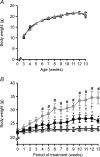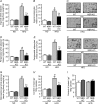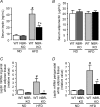Female mice target deleted for the neuromedin B receptor have partial resistance to diet-induced obesity
- PMID: 20211980
- PMCID: PMC2876815
- DOI: 10.1113/jphysiol.2009.185322
Female mice target deleted for the neuromedin B receptor have partial resistance to diet-induced obesity
Abstract
Previous studies have proposed a role for neuromedin B (NB), a bombesin-like peptide, in the control of body weight homeostasis. However, the nature of this role is unclear. The actions of NB are mediated preferentially by NB-preferring receptors (NBRs). Here we examined the consequences of targeted deletion of NBRs in female mice on body weight homeostasis in mice fed a normolipid diet (ND) or a high-fat diet (HFD) for 13 weeks. Body weight and food ingestion of neuromedin B receptor knockout (NBR-KO) mice fed a normolipid diet showed no difference in relation to wild-type (WT). However, the high-fat diet induced an 8.9- and 4.8-fold increase in body weight of WT and NBR-KO, respectively, compared to their controls maintained with a normolipid diet, even though the mice ingested the same amount of calories, regardless of genotype. Comparing mice fed the high-fat diet, NBR-KO mice accumulated approximately 45% less fat depot mass than WT, exhibited a lower percentage of fat in their carcasses (19.2 vs. 31.3%), and their adipocytes were less hypertrophied. Serum leptin and leptin mRNA in inguinal and perigonadal fat were lower in HFD NBR-KO than HFD WT, and serum adiponectin was similar among HFD groups and unaltered in comparison to ND-fed mice. HFD-fed WT mice developed glucose intolerance but not the HFD-fed NBR-KO mice, although they had similar glycaemia and insulinaemia. NBR-KO and WT mice on the normolipid diet showed no differences in any parameters, except for a trend to lower insulin levels. Therefore, disruption of the neuromedin B receptor pathway did not change body weight homeostasis in female mice fed a normolipid diet; however, it did result in partial resistance to diet-induced obesity.
Figures






Comment in
-
To B or not to B: Fat is the question.J Physiol. 2010 May 1;588(Pt 9):1393-4. doi: 10.1113/jphysiol.2010.190165. J Physiol. 2010. PMID: 20436044 Free PMC article. No abstract available.
References
-
- Bouchard L, Drapeau V, Provencher V, Lemieux S, Chagnon Y, Rice T, Rao DC, Vohl MC, Tremblay A, Bouchard C, Pérusse L. Neuromedin β: a strong candidate gene linking eating behaviors and susceptibility to obesity. Am J Clin Nutr. 2004;80:1478–1486. - PubMed
-
- Bradford MM. A rapid and sensitive method for the quantitation of microgram quantities of protein utilizing the principle of protein-dye binding. Anal Biochem. 1976;72:248–254. - PubMed
-
- Gibbs J, Smith GP. The actions of bombesin-like peptides on food intake. Ann N Y Acad Sci. 1988;547:210–216. - PubMed
Publication types
MeSH terms
Substances
LinkOut - more resources
Full Text Sources
Medical
Molecular Biology Databases
Research Materials

